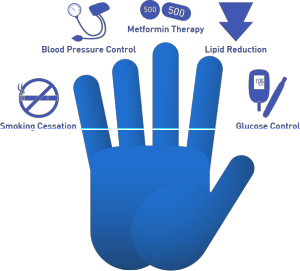Lending a Hand and Missing The Point
 An editorial in a February issue of American Family Physician proposed a simple way for physicians to communicate treatment priorities for patients with type 2 diabetes. Their "hand" illustration re-prioritizes treatment goals. It conveys that glycemic control or blood sugar control is no longer the top priority. The new medical treatment priority model illustrates that glucose control is not as important as smoking cessation, blood pressure control, use of metformin, and lipid control.This proposed change of the treatment goal priorities for people with diabetes, while it may be a step in the right direction, is not optimal.From my perspective, this new proposed "lending a finger" proposal is not all that much better than the prior myopic focus on blood sugar control, carbohydrate counting, and glycemic load. Indeed the "hand" actually missed the two most important factors for not only improving and reversing insulin resistance (and associated metabolic ills), but also increasing longevity in people with type 2 diabetes and the metabolic syndrome.My "lending a finger" hand would look like the two finger peace sign.
An editorial in a February issue of American Family Physician proposed a simple way for physicians to communicate treatment priorities for patients with type 2 diabetes. Their "hand" illustration re-prioritizes treatment goals. It conveys that glycemic control or blood sugar control is no longer the top priority. The new medical treatment priority model illustrates that glucose control is not as important as smoking cessation, blood pressure control, use of metformin, and lipid control.This proposed change of the treatment goal priorities for people with diabetes, while it may be a step in the right direction, is not optimal.From my perspective, this new proposed "lending a finger" proposal is not all that much better than the prior myopic focus on blood sugar control, carbohydrate counting, and glycemic load. Indeed the "hand" actually missed the two most important factors for not only improving and reversing insulin resistance (and associated metabolic ills), but also increasing longevity in people with type 2 diabetes and the metabolic syndrome.My "lending a finger" hand would look like the two finger peace sign. Index Finger: "Weight Loss" This would be achieved not by calorie counting but by changing what people with type 2 diabetes are told to eat. Rather than focus on counting grams of carbohydrate, patients should shift their focus to eating less processed foods with lower calorie density and higher fiber content. That diet would be composed largely of whole grains, fruits, and vegetables, with marked reductions in salt, sugar-rich drinks, and fatty animal products.Middle Finger: "Exercise"This would consist of at least one hour of daily aerobic exercise, with additional resistance training 2-3 times per week. It would also discourage long periods of sitting.By James J. Kenney, PhD FACNNote: A more robust and detailed discussion of this topic is available in the April 2014 issue of Communicating Food for Health. Subscribers can read it right now. If you don't have a membership yet, get the details and subscribe today!
Index Finger: "Weight Loss" This would be achieved not by calorie counting but by changing what people with type 2 diabetes are told to eat. Rather than focus on counting grams of carbohydrate, patients should shift their focus to eating less processed foods with lower calorie density and higher fiber content. That diet would be composed largely of whole grains, fruits, and vegetables, with marked reductions in salt, sugar-rich drinks, and fatty animal products.Middle Finger: "Exercise"This would consist of at least one hour of daily aerobic exercise, with additional resistance training 2-3 times per week. It would also discourage long periods of sitting.By James J. Kenney, PhD FACNNote: A more robust and detailed discussion of this topic is available in the April 2014 issue of Communicating Food for Health. Subscribers can read it right now. If you don't have a membership yet, get the details and subscribe today!Postscript: A study released after this article was written supports its conclusion that it would be far better for people with type 2 diabetes to lose weight and exercise to control or even largely eliminate their disease than to simply take multiple drugs to control its varied metabolic problems. This new study proves type 2 diabetes is largely caused by an unhealthy diet and lifestyle that leads to an increased accumulation of body fat. In this research, published in the Feb. 6 issue of the American Journal of Human Genetics, Dr. Keating and V. Holmes, M.D., Ph.D., of the Perelman School of Medicine at the University of Pennsylvania used a recently-developed epidemiology tool called Mendelian randomization (MR) that rules out confounding factors such as behavioral and environmental influences to construct genetic risk scores for specific traits of interest. The study team analyzed eight population groups including over 34,000 individuals of European descent, of whom over 4,400 had type 2 diabetes.
Their analysis demonstrated the causal relationship between increasing BMI in promoting insulin resistance and other metabolic abnormalities that markedly increase the risk of developing type 2 diabetes. "Our findings suggest that lowering BMI is likely to result in multiple reductions of cardiovascular traits: in blood pressure, inflammation, fasting glucose and insulin, and in the risk of type 2 diabetes," said Dr. Keating.
Source: "Causal Effects of Body Mass Index on Cardiometabolic Traits and Events: A Mendelian Randomization Analysis," American Journal of Human Genetics, published online Jan. 23, 2014 and in print Feb. 6, 2014. doi.10.1016/j.ajhg.2013.12.014
